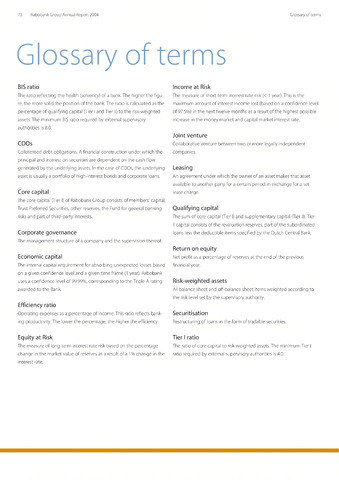Glossary of terms
BIS ratio
CDOs
Core capital
Equity at Risk
Leasing
Qualifying capital
Risk-weighted assets
Securitisation
Tier I ratio
73 Rabobank Group Annual Report 2004
Glossary of terms
The ratio reflecting the health (solvency) of a bank. The higher the figu
re, the more solid the position of the bank. The ratio is calculated as the
percentage of qualifying capital (Tier I and Tier II) to the risk-weighted
assets. The minimum BIS ratio required by external supervisory
authorities is 8.0.
Collaterised debt obligations. A financial construction under which the
principal and interest on securities are dependent on the cash flow
generated by the underlying assets. In the case of CDOs, the underlying
asset is usually a portfolio of high-interest bonds and corporate loans.
The core capital (Tier I) of Rabobank Group consists of members' capital,
Trust Preferred Securities, other reserves, the Fund for general banking
risks and part of third-party interests.
Corporate governance
The management structure of a company and the supervision thereof.
Economic capital
The internal capital requirement for absorbing unexpected losses based
on a given confidence level and a given time frame (1 year). Rabobank
uses a confidence level of 99.99%, corresponding to the Triple A rating
awarded to the Bank.
Efficiency ratio
Operating expenses as a percentage of income. This ratio reflects bank
ing productivity. The lower the percentage, the higher the efficiency.
The measure of long-term interest rate risk based on the percentage
change in the market value of reserves as a result of a 1% change in the
interest rate.
Income at Risk
The measure of short-term interest rate risk 1 year). This is the
maximum amount of interest income lost (based on a confidence level
of 97.5%) in the next twelve months as a result of the highest possible
increase in the money market and capital market interest rate.
Joint venture
Collaborative venture between two or more legally independent
companies.
An agreement under which the owner of an asset makes that asset
available to another party for a certain period in exchange for a set
lease charge.
The sum of core capital (Tier I) and supplementary capital (Tier II). Tier
II capital consists of the revaluation reserves, part of the subordinated
loans less the deductible items specified by the Dutch Central Bank.
Return on equity
Net profit as a percentage of reserves at the end of the previous
financial year.
All balance sheet and off-balance sheet items weighted according to
the risk level set by the supervisory authority.
Restructuring of loans in the form of tradable securities.
The ratio of core capital to risk-weighted assets. The minimum Tier I
ratio required by external supervisory authorities is 4.0.

